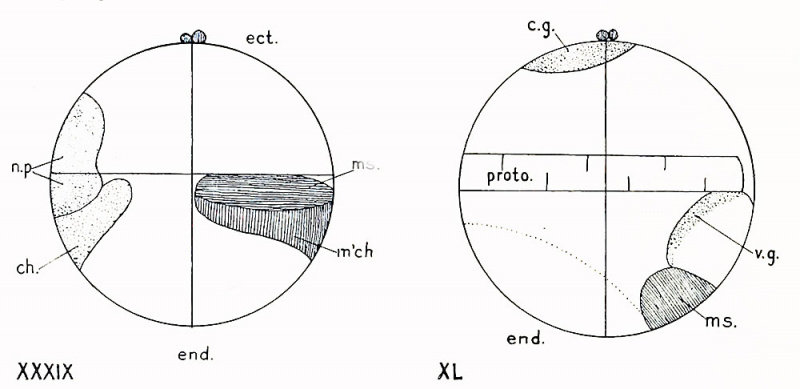File:Conklin 1905 fig34-35.jpg

Original file (1,000 × 486 pixels, file size: 59 KB, MIME type: image/jpeg)
Fig. 34 - 35
Figs. XXXIX, XL. Diagramatic representations of the types of germinal localization in ascidians and annelids. Mesodermal substance is shaded by lines, neural substance by fine stipples, and chorda material by coarse stipples. Fig. XXXIX, the ascidian type; egg viewed from right side. The mesoplasm, composed of mesenchyme (m'ch) and muscle substance (msl, is represented in its final position, which it assumes before the first cleavage. The neural plate (n. p.) and chorda (eh.) substances are not distinguishable in the unsegmented egg. but are here shown in the positions in which they appear at the 2-cell stage; the chorda and mesenchyme substances should be shown as meeting on the side of the egg, thus forming a chorda-mesenchyme ring around the endoderm. The ectoplasm (ect.) and endoplasm (end.) are localized, as here represented, at the close of the first cleavage. Fig. XL, the annelid type; egg viewed from left side. The substances of the first and second somatoblasts (the former stippled along one border, the latter shaded by lines) are shown in the positions in which these cells are ultimately formed ; in the unsegmented egg the lobe which contains the substances of these cells lies nearer the lower pole. The substances of the cerebral ganglion (c. g.), ventral ganglia (v. g.) and prototroch (proto.) are not distinguishable in the unsegmented egg, but are shown in the regions to which they may be traced by means of the cell lineage.
| Historic Disclaimer - information about historic embryology pages |
|---|
| Pages where the terms "Historic" (textbooks, papers, people, recommendations) appear on this site, and sections within pages where this disclaimer appears, indicate that the content and scientific understanding are specific to the time of publication. This means that while some scientific descriptions are still accurate, the terminology and interpretation of the developmental mechanisms reflect the understanding at the time of original publication and those of the preceding periods, these terms, interpretations and recommendations may not reflect our current scientific understanding. (More? Embryology History | Historic Embryology Papers) |
- Conklin Figures: Fig 1-2 | Fig 3-6 | Fig 7-8 | Fig 9-12 | Fig 13-16 | Fig 17-20 | Fig 21-24 | Fig 25-26 | Fig 27-33 | Fig 34-35 | Plate I | Plate II | Plate III | Plate IV | Plate V | Plate VI | Plate VII | Plate VIII | Plate IX | Plate X | Plate XI | Plate XII
Reference
Conklin EG. The Organization and Cell-Lineage of the Ascidian Egg (1905) J. Acad., Nat. Sci. Phila. 13, 1.
Conklin 1905 TOC: I. The Ovarian Egg | II. Maturation and Fertilization | III. Orientation of Egg and Embryo | IV. Cell-Lineage | V. Later Development | VI. Comparisons with A.mphioxus and Amphibia | VII. The Organization of the Egg | Summary | Literature Cited | Explanation of Figures
Cite this page: Hill, M.A. (2024, April 27) Embryology Conklin 1905 fig34-35.jpg. Retrieved from https://embryology.med.unsw.edu.au/embryology/index.php/File:Conklin_1905_fig34-35.jpg
- © Dr Mark Hill 2024, UNSW Embryology ISBN: 978 0 7334 2609 4 - UNSW CRICOS Provider Code No. 00098G
File history
Click on a date/time to view the file as it appeared at that time.
| Date/Time | Thumbnail | Dimensions | User | Comment | |
|---|---|---|---|---|---|
| current | 17:21, 19 October 2016 |  | 1,000 × 486 (59 KB) | Z8600021 (talk | contribs) | |
| 17:20, 19 October 2016 |  | 1,000 × 796 (176 KB) | Z8600021 (talk | contribs) | {{Historic Disclaimer}} {{Conklin1905 figures}} ===Reference=== {{Ref-Conklin1905}} {{Conklin1905 TOC}} {{Footer}} |
You cannot overwrite this file.
File usage
The following 2 pages use this file:
